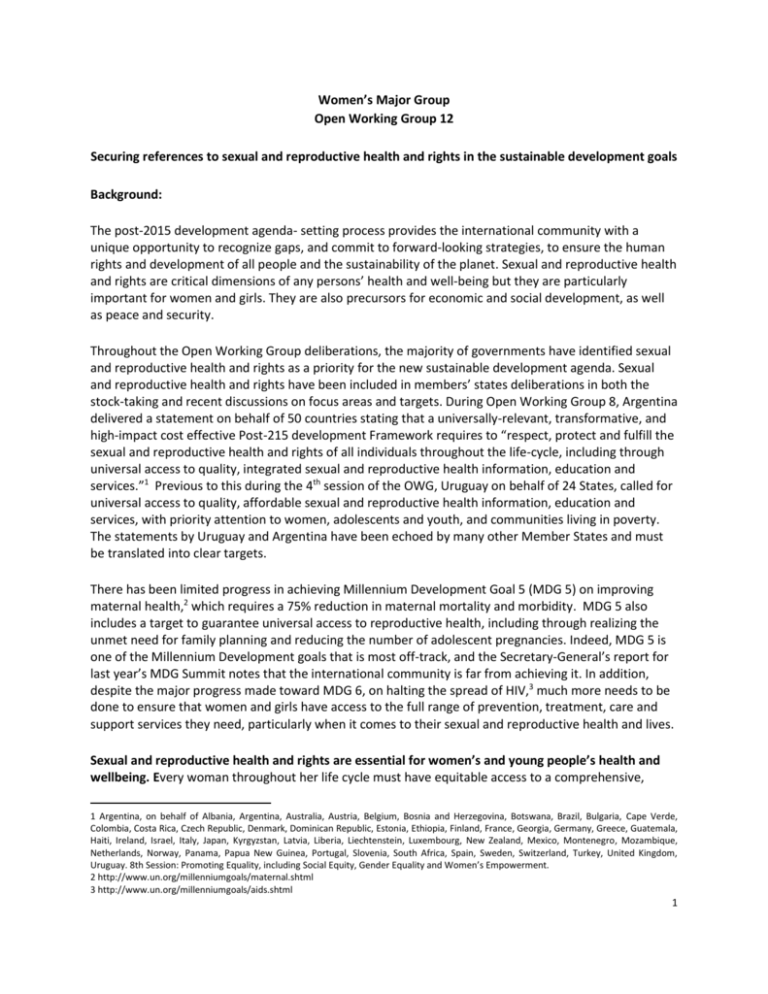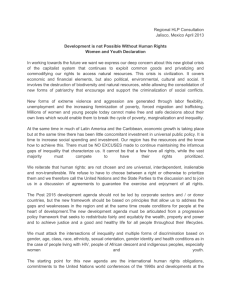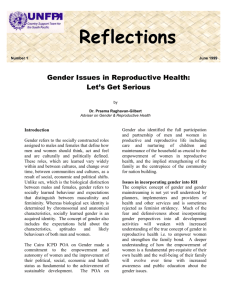
Women’s Major Group
Open Working Group 12
Securing references to sexual and reproductive health and rights in the sustainable development goals
Background:
The post-2015 development agenda- setting process provides the international community with a
unique opportunity to recognize gaps, and commit to forward-looking strategies, to ensure the human
rights and development of all people and the sustainability of the planet. Sexual and reproductive health
and rights are critical dimensions of any persons’ health and well-being but they are particularly
important for women and girls. They are also precursors for economic and social development, as well
as peace and security.
Throughout the Open Working Group deliberations, the majority of governments have identified sexual
and reproductive health and rights as a priority for the new sustainable development agenda. Sexual
and reproductive health and rights have been included in members’ states deliberations in both the
stock-taking and recent discussions on focus areas and targets. During Open Working Group 8, Argentina
delivered a statement on behalf of 50 countries stating that a universally-relevant, transformative, and
high-impact cost effective Post-215 development Framework requires to “respect, protect and fulfill the
sexual and reproductive health and rights of all individuals throughout the life-cycle, including through
universal access to quality, integrated sexual and reproductive health information, education and
services.”1 Previous to this during the 4th session of the OWG, Uruguay on behalf of 24 States, called for
universal access to quality, affordable sexual and reproductive health information, education and
services, with priority attention to women, adolescents and youth, and communities living in poverty.
The statements by Uruguay and Argentina have been echoed by many other Member States and must
be translated into clear targets.
There has been limited progress in achieving Millennium Development Goal 5 (MDG 5) on improving
maternal health,2 which requires a 75% reduction in maternal mortality and morbidity. MDG 5 also
includes a target to guarantee universal access to reproductive health, including through realizing the
unmet need for family planning and reducing the number of adolescent pregnancies. Indeed, MDG 5 is
one of the Millennium Development goals that is most off-track, and the Secretary-General’s report for
last year’s MDG Summit notes that the international community is far from achieving it. In addition,
despite the major progress made toward MDG 6, on halting the spread of HIV,3 much more needs to be
done to ensure that women and girls have access to the full range of prevention, treatment, care and
support services they need, particularly when it comes to their sexual and reproductive health and lives.
Sexual and reproductive health and rights are essential for women’s and young people’s health and
wellbeing. Every woman throughout her life cycle must have equitable access to a comprehensive,
1 Argentina, on behalf of Albania, Argentina, Australia, Austria, Belgium, Bosnia and Herzegovina, Botswana, Brazil, Bulgaria, Cape Verde,
Colombia, Costa Rica, Czech Republic, Denmark, Dominican Republic, Estonia, Ethiopia, Finland, France, Georgia, Germany, Greece, Guatemala,
Haiti, Ireland, Israel, Italy, Japan, Kyrgyzstan, Latvia, Liberia, Liechtenstein, Luxembourg, New Zealand, Mexico, Montenegro, Mozambique,
Netherlands, Norway, Panama, Papua New Guinea, Portugal, Slovenia, South Africa, Spain, Sweden, Switzerland, Turkey, United Kingdom,
Uruguay. 8th Session: Promoting Equality, including Social Equity, Gender Equality and Women’s Empowerment.
2 http://www.un.org/millenniumgoals/maternal.shtml
3 http://www.un.org/millenniumgoals/aids.shtml
1
accessible, and integrated package of sexual and reproductive health services that are acceptable and of
quality and that fully respect women’s sexual and reproductive rights. The package of services all
women must be provided includes: all contraceptives of their choice, including emergency
contraception, male and female condoms; maternity care which includes pre- and post natal care,
skilled birth attendance and emergency obstetric care; safe and legal abortion services and post
abortion care; prevention, timely diagnosis and treatment of infertility, HIV and sexually transmitted
infections; prevention, early detection and treatment of reproductive cancers.
Further, it is important to recognize that the use of abortion reflects many circumstances that can be
difficult for women to prevent, such as contraceptive failure, lack of knowledge about the fertile period
or how to use contraception, shortfalls in access and affordability of contraceptives, changing fertility
aspirations, disparities in the desire for a pregnancy between a woman and her partner, fear of asking a
partner to use contraception, unplanned or forced sex.4 According to the Secretary General Report
ICPD+20 Review “Governments should take urgent, concrete measures to further reduce abortionrelated complications and deaths by providing non-discriminatory post-abortion care that meets WHO
guidelines. Governments are encouraged to remove legal barriers preventing women and adolescent
girls from access to safe abortion, including revising restrictions within existing abortion laws, and where
legal, should ensure the availability of safe, good-quality abortion services, in order to safeguard the
lives of women and girls.”5
While there has been significant progress in improving sexual and reproductive health over the past
twenty years there is much that still needs to be done.6
Globally, 222 million women and girls have an unmet need for modern contraception majority
of them are based in the Global South.7
287,000 women died from complications of pregnancy and childbirth in 2010, with millions
more suffering complications and injuries.
13% of maternal deaths are due to unsafe abortions, most of them in Africa and Asia.
Between 2 and 3.5 million women are living with fistula in developing countries.8
More than 500,000 women develop cervical cancer annually and 275,000 women die from it,
95% of them in developing countries.9
The incidence of the sexually transmitted infections (STIs) chlamydia, syphilis, trichomoniasis,
and gonorrhea has increased from 333 million cases per year in 1995 to 499 million cases per
year in 2008. The disease burden of STIs in women is more than five times that of men.10
Fully meeting the need for modern contraceptive services in the developing world would require an
additional investment of $4.1 billion, but would save roughly $5.7 billion in maternal and newborn
health services costs.11
4
UNFPA Report of the Operational Review of the Implementation of the Programme of Action of the International Conference on Population
and Development and its Follow-up Beyond 2014
5 Secretary General Report ICPD+20 Review (E/CN.9/2014/4)
6 Secretary-General, Framework of action for the follow-up to the Programme of Action of the International Conference on Population and
Development beyond 2014, E/CN.9/2014/4
7 Guttmacher Institute & UNFPA, Adding it Up: The Benefits of Investing in Sexual and Reproductive Healthcare
(2009),http://www.unfpa.org/webdav/site/global/shared/documents/publications/2004/addingitup.pdf
8
Secretary-General, Framework of action for the follow-up to the Programme of Action of the International Conference on Population and
Development beyond 2014, E/CN.9/2014/4
9 Secretary-General, Framework of action for the follow-up to the Programme of Action of the International Conference on Population and
Development beyond 2014, E/CN.9/2014/4
10 Secretary-General, Framework of action for the follow-up to the Programme of Action of the International Conference on Population and
Development beyond 2014, E/CN.9/2014/4
2
Sexual and reproductive health and rights are essential for economic development. The World Bank
reports that if women are able to better control their fertility through, for example, access to family
planning, then as girls they can also stay in school longer, accumulate more skills, and eventually earn
higher wages.12 Female labour force participation decreases with each additional child: by about 10 to
15 percentage points among women aged 25 to 39, and about 5 to 10 percentage points among women
aged 40 to 49.13
Sexual and reproductive health and rights are essential for gender equality and women’s
empowerment. In order to achieve gender equality women and girls must be free to decide all matters
related to their sexuality and reproduction free from coercion, discrimination, or violence. Without the
ability to make fundamental decisions about their sexual lives, the number and spacing of their children,
whether and who to marry, women are simply not able to participate on an equal basis in society.
Attaining gender equality also requires eliminating structural, legal and economic barriers that prevent
women of all ages from accessing or using the sexual and reproductive health information and services
they need and that enable their full and equal participation in education, employment and decisionmaking. Denial of women’s sexual and reproductive health and rights perpetuates gender inequalities,
undermines women’s girls’ opportunities for education and employment, and exacerbates poverty as
well as women’s experiences of intersecting forms of discrimination. When women are empowered to
make decisions about their sexuality and reproduction they are more empowered to make decisions
about their lives in general, contributing to social and economic development.
The international community has a moral imperative to secure women’s and girls’ sexual and
reproductive health and rights.
RECOMMENDATIONS
The current Zero Draft provides two key entry points to ensure clear targets on SRHR: under the focus
area on health and population dynamics and the focus area on gender equality and women’s
empowerment.
The Women’s Major Group urges our governments to seek consensus on the following:
Preamble
Include in paragraph 3 of the draft Chapeau, or alternatively as an additional paragraph on other agreed
texts, references to “the Programme of Action of the International Conference on Population and
Development and the Key Actions for its further implementation and the Declaration, the Beijing
11
Guttmacher Institute & UNFPA, Fact Sheet “Costs and Benefits of Investing in Contraceptive Services in the Developing World”
(2012), http://www.guttmacher.org/pubs/FB-Costs-Benefits-Contraceptives.pdf
12 World Bank & Women Deliver Report, Closing the Deadly Gap Between What We Know and What We Do: Investing in Reproductive Health,
2013.
13 World Bank & Women Deliver Report, Closing the Deadly Gap Between What We Know and What We Do: Investing in Reproductive Health,
2013.
3
Declaration and Platform for Action and its Further Actions and Initiatives, and the outcomes of their
review conferences.”
These documents form the foundational core of existing development agreements that underpin the
next development framework and warrant inclusion in the chapeau to the SDGs.
Include in paragraph 5 of the chapeau the following additions: “We further recognize that the needs of
adolescents and young people, as the stewards of this next development agenda, must be integrated
across all dimensions of sustainable development. Adolescents and youth should be involved in the
development, implementation, monitoring and evaluation of programs that impact their lives.”
A critical shortcoming of the MDGs was their failure to substantively address the needs of adolescents
and young people. There are over 1.8 billion young people in the world today, 90 percent of whom live
in developing countries.14 It is essential that the Post-2015 Development Agenda recognize the
multifaceted and cross-cutting needs of adolescents and youth, with a focus on their human rights and
health needs.
Goal 3. Attain healthy life for all at all ages
Proposed in Zero Draft:
3.1 by 2030 reduce the maternal mortality ratio to less than 40 per 100,000 live births
3.3 by 2030 end HIV/AIDS, tuberculosis, malaria, and neglected tropical diseases
3.8 ensure universal access to sexual and reproductive health for all
Recommendations:
3.1 By 2030 eliminate preventable reduce the maternal mortality and morbidity ratio to less than 40
per 100,000 live births.
3.3 By 2030 end HIV/AIDS, tuberculosis, malaria, and neglected tropical diseases by guaranteeing
equitable, universal and affordable access to prevention, treatment, care and support for all people
across the life course, with a particular focus on adolescents and young people.
3.8 By 2030 ensure universal access to high-quality comprehensive, equitable and integrated sexual
and reproductive health services, information and education, and respect, protect and fulfill all human
rights in this regard, with a particular focus on adolescents and young people.
Key Messages
It is essential to include a reference to adolescents and young people in target 3.8. Adolescents and
young people have unique sexual and reproductive health needs that require urgent action:
14
UNFPA, Fact Sheet “Adolescent and Youth Demographics: A Brief Overview” (2013),
https://www.unfpa.org/webdav/site/global/shared/factsheets/One%20pager%20on%20youth%20demographics%20GF.pdf
4
o
o
o
Adolescents aged 15-19 are twice as likely to die during pregnancy or child birth as those
over age 20; girls under age 15 are five times more likely to die.15
According to the most recent data available (2004), adolescents account for an estimated
2.5 million (14%) of the approximately 19 million unsafe abortions that occur annually in the
developing world. In Sub-Saharan Africa, adolescents account for 25% of the total unsafe
abortions.16
In 2010 young people aged 15–24 accounted for 42% of new HIV infections in people aged
15 and older. Among young people living with HIV, nearly 80% (4 million) live in sub-Saharan
Africa.17
Goal 4. Provide equitable and inclusive quality education and life-long learning opportunities for all
There is no mention of adolescents or comprehensive sexuality education in the Zero Draft. Sustainable
development will only occur when girls and boys alike understand their bodies, know their rights, and
have the necessary skills to negotiate on important aspects of their lives.
Recommendations:
Preferred new target:
4.10 By 2030, ensure universal access to comprehensive sexuality education that promotes values of
respect for human rights, tolerance, gender equality and non-violence for all, in and out of schools.
Or, include CSE in target 4.7, as follows:
4.7 By 2030 integrate relevant knowledge and skills in education curricula and training programs,
including comprehensive sexuality education, life skills, education for sustainable development, and
human rights education and awareness-raising on culture’s contribution to sustainable development
Key Messages:
Over 50 governments spoke up in support of CSE during OWG 8, and governments have committed
to providing “evidence-based comprehensive education on human sexuality” as recently at CSW 58
and CPD 47.
CSE should be understood as age-appropriate education about human rights, human sexuality,
gender equality, relationships and sexual and reproductive health and rights through the provision
of scientifically-accurate, non-judgmental information. Comprehensive sexuality education is
essential for young people to be able to protect themselves from unwanted pregnancy, HIV and
sexually transmitted infections, to promote values of tolerance, mutual respect and non-violence in
relationships, and to plan their lives.
A review from UNESCO of 87 comprehensive sexuality education programs, including 29 in
developing countries, found a number of positive outcomes: delayed initiation of sexual intercourse,
decreased number of sexual partners, increased use of condoms and decreased sexual risk taking.
No studies showed hastened initiation of sex, an increased number of sexual partners, or decreased
use of condoms.
15
UNFPA State of the World’s Population Report, Motherhood in Childhood: Facing the Challenge of Adolescent Pregnancy, 2013.
Shah I and Ahman E, Age patterns of unsafe abortion in developing country regions, Reproductive Health Matters, 2004, 12(24 suppl.):9–17.
17
UNAIDS World AIDS Day Report, 2012.
16
5
Goal 5: Attain gender equality, empower women and girls everywhere
Proposed in Zero Draft:
5.3 Eliminate all harmful practices including child, early and forced marriage and female genital
mutilations.
5.9 Ensure universal access to sexual and reproductive health and reproductive rights in accordance with
the Programme of Action of the ICPD.
Recommendations:
5.3 Strongly support the inclusion of both child, early and forced marriage and female genital mutilation.
5.9: By 2030 ensure universal access to sexual and reproductive health and reproductive rights free
from stigma, violence, coercion and discrimination for all women and girls of all ages in accordance
with the Programme of Action of the ICPD
Key Messages:
The women’s human rights community cautions against the use of a qualifier in a target on universal
access to sexual and reproductive health. The new development framework demands a forwardlooking outcome and such qualification would limit what can be achieved to ensure gender equality
for women and girls.
It is essential to recognize women and girls of all ages in target 5.9. Adolescent girls face unique
barriers to realizing their sexual and reproductive rights, including discriminatory laws and practices
such as parental and spousal notification laws.
6








